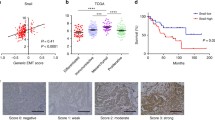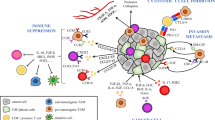Abstract
We previously found that cancer metastasis is accelerated by immunosuppression during Snail-induced epithelial-to-mesenchymal transition (EMT). However, the molecular mechanism still remained unclear. Here, we demonstrate that CCL2 is a critical determinant for both tumor metastasis and immunosuppression induced by Snail+ tumor cells. CCL2 is significantly upregulated in various human tumor cells accompanied by Snail expression induced by snail transduction or TGFβ treatment. The Snail+ tumor-derived CCL2 amplifies EMT events in other cells including Snail− tumor cells and epithelial cells within tumor microenvironment. CCL2 secondarily induces Lipocalin 2 (LCN2) in the Snail+ tumor cells in an autocrine manner. CCL2 and LCN2 cooperatively generate immunoregulatory dendritic cells (DCreg) having suppressive activity accompanied by lowered expression of costimulatory molecules such as HLA-DR but increased expression of immunosuppressive molecules such as PD-L1 in human PBMCs. The CCL2/LCN2-induced DCreg cells subsequently induce immunosuppressive CD4+FOXP3+ Treg cells, and finally impair tumor-specific CTL induction. In murine established tumor model, however, CCL2 blockade utilizing the specific siRNA or neutralizing mAb significantly inhibits Snail+ tumor growth and metastasis following systemic induction of anti-tumor immune responses in host. These results suggest that CCL2 is more than a chemoattractant factor that is the significant effector molecule responsible for immune evasion of Snail+ tumor cells. CCL2 would be an attractive target for treatment to eliminate cancer cells via amelioration of tumor metastasis and immunosuppression.







Similar content being viewed by others
Abbreviations
- BM:
-
Bone marrow
- CA:
-
Cryoablation
- DC:
-
Dendritic cell
- DCreg:
-
Immunoregulatory dendritic cell
- EMT:
-
Epithelial-to-mesenchymal transition
- F10-mock:
-
B16-F10 cells transduced with empty vector
- F3-snail+ :
-
Panc1 cells transduced with human snail cDNA
- H6-snail+ :
-
B16-F10 cells transduced with murine snail cDNA
- i.t. (IT):
-
Intratumoral(ly)
- LCN2:
-
Lipocalin 2
- MDSCs:
-
Myeloid-derived suppressor cells
- MFI:
-
Mean of fluorescence intensity
- MSCs:
-
Mesenchymal stem cells
- Panc1-mock:
-
Panc1 cells mock-transfected with empty vector
- SPCs:
-
Spleen cells
- TAMs:
-
Tumor-associated macrophages
- Treg:
-
Regulatory T cells
- TSP1:
-
Thrombospondin 1
References
Radisky DC (2005) Epithelial-mesenchymal transition. J Cell Sci 118(Pt 19):4325–4326
Hugo H, Ackland ML, Blick T, Lawrence MG, Clements JA, Williams ED, Thompson EW (2007) Epithelial–mesenchymal and mesenchymal–epithelial transitions in carcinoma progression. J Cell Physiol 213(2):374–383
Huber MA, Kraut N, Beug H (2005) Molecular requirements for epithelial-mesenchymal transition during tumor progression. Curr Opin Cell Biol 17(5):548–558
Hotz B, Arndt M, Dullat S, Bhargava S, Buhr HJ, Hotz HG (2007) Epithelial to mesenchymal transition: expression of the regulators snail, slug, and twist in pancreatic cancer. Clin Cancer Res 13(16):4769–4776
Yin T, Wang C, Liu T, Zhao G, Zha Y, Yang M (2007) Expression of snail in pancreatic cancer promotes metastasis and chemoresistance. J Surg Res 141(2):196–203
Kuphal S, Palm HG, Poser I, Bosserhoff AK (2005) Snail-regulated genes in malignant melanoma. Melanoma Res 15(4):305–313
Dissanayake SK, Wade M, Johnson CE, O’Connell MP, Leotlela PD, French AD, Shah KV, Hewitt KJ, Rosenthal DT, Indig FE, Jiang Y, Nickoloff BJ, Taub DD, Trent JM, Moon RT, Bittner M, Weeraratna AT (2007) The Wnt5A/protein kinase C pathway mediates motility in melanoma cells via the inhibition of metastasis suppressors and initiation of an epithelial to mesenchymal transition. J Biol Chem 282(23):17259–17271
Moody SE, Perez D, Pan TC, Sarkisian CJ, Portocarrero CP, Sterner CJ, Notorfrancesco KL, Cardiff RD, Chodosh LA (2005) The transcriptional repressor Snail promotes mammary tumor recurrence. Cancer Cell 8(3):197–209
Yang MH, Chang SY, Chiou SH, Liu CJ, Chi CW, Chen PM, Teng SC, Wu KJ (2007) Overexpression of NBS1 induces epithelial-mesenchymal transition and co-expression of NBS1 and Snail predicts metastasis of head and neck cancer. Oncogene 26(10):1459–1467
Kudo-Saito C, Shirako H, Takeuchi T, Kawakami Y (2009) Cancer metastasis is accelerated through immunosuppression during Snail-induced EMT of cancer cells. Cancer Cell 15(3):195–206
Inozume T, Matsuzaki Y, Kurihara S, Fujita T, Yamamoto A, Aburatani H, Shimada S, Kawakami Y (2005) Novel melanoma antigen, FCRL/FREB, identified by cDNA profile comparison using DNA chip are immunogenic in multiple melanoma patients. Int J Cancer 114(2):283–290
Yamaguchi H, Tanaka F, Ohta M, Inoue H, Mori M (2004) Identification of HLA-A24-restricted CTL epitope from cancer-testis antigen, NY-ESO-1, and induction of a specific antitumor immune response. Clin Cancer Res 10(3):890–896
Lu Y, Chen Q, Corey E, Xie W, Fan J, Mizokami A, Zhang J (2009) Activation of MCP-1/CCR2 axis promotes prostate cancer growth in bone. Clin Exp Metastasis 26(2):161–169
Cai Z, Chen Q, Chen J, Lu Y, Xiao G, Wu Z, Zhou Q, Zhang J (2009) Monocyte chemotactic protein 1 promotes lung cancer-induced bone resorptive lesions in vivo. Neoplasia 11(3):228–236
Soria G, Ofri-Shahak M, Haas I, Yaal-Hahoshen N, Leider-Trejo L, Leibovich-Rivkin T, Weitzenfeld P, Meshel T, Shabtai E, Gutman M, Ben-Baruch A (2011) Inflammatory mediators in breast cancer: coordinated expression of TNFalpha & IL-1beta with CCL2 & CCL5 and effects on epithelial-to-mesenchymal transition. BMC Cancer 11:130
Tang CH, Tsai CC (2012) CCL2 increases MMP-9 expression and cell motility in human chondrosarcoma cells via the Ras/Raf/MEK/ERK/NF-kappaB signaling pathway. Biochem Pharmacol 83(3):335–344
Lu Y, Cai Z, Galson DL, Xiao G, Liu Y, George DE, Melhem MF, Yao Z, Zhang J (2006) Monocyte chemotactic protein-1 (MCP-1) acts as a paracrine and autocrine factor for prostate cancer growth and invasion. Prostate 66(12):1311–1318
Nam JS, Kang MJ, Suchar AM, Shimamura T, Kohn EA, Michalowska AM, Jordan VC, Hirohashi S, Wakefield LM (2006) Chemokine (C–C motif) ligand 2 mediates the prometastatic effect of dysadherin in human breast cancer cells. Cancer Res 66(14):7176–7184
Taylor MA, Lee YH, Schiemann WP (2011) Role of TGF-beta and the tumor microenvironment during mammary tumorigenesis. Gene Expr 15(3):117–132
Zu X, Zhang Q, Cao R, Liu J, Zhong J, Wen G, Cao D (2012) Transforming growth factor-beta signaling in tumor initiation, progression and therapy in breast cancer: an update. Cell Tissue Res 347(1):73–84
Fujisawa T, Joshi BH, Puri RK (2012) IL-13 regulates cancer invasion and metastasis through IL-13Ralpha2 via ERK/AP-1 pathway in mouse model of human ovarian cancer. Int J Cancer 131(2):344–356
Yadav A, Kumar B, Datta J, Teknos TN, Kumar P (2011) IL-6 promotes head and neck tumor metastasis by inducing epithelial-mesenchymal transition via the JAK-STAT3-SNAIL signaling pathway. Mol Cancer Res 9(12):1658–1667
Fernando RI, Castillo MD, Litzinger M, Hamilton DH, Palena C (2011) IL-8 signaling plays a critical role in the epithelial-mesenchymal transition of human carcinoma cells. Cancer Res 71(15):5296–5306
Devireddy LR, Gazin C, Zhu X, Green MR (2005) A cell-surface receptor for lipocalin 24p3 selectively mediates apoptosis and iron uptake. Cell 123(7):1293–1305
Lin H, Monaco G, Sun T, Ling X, Stephens C, Xie S, Belmont J, Arlinghaus R (2005) Bcr-Abl-mediated suppression of normal hematopoiesis in leukemia. Oncogene 24(20):3246–3256
Yang J, Bielenberg DR, Rodig SJ, Doiron R, Clifton MC, Kung AL, Strong RK, Zurakowski D, Moses MA (2009) Lipocalin 2 promotes breast cancer progression. Proc Natl Acad Sci USA 106(10):3913–3918
Shi H, Gu Y, Yang J, Xu L, Mi W, Yu W (2008) Lipocalin 2 promotes lung metastasis of murine breast cancer cells. J Exp Clin Cancer Res 27:83
Bauer M, Eickhoff JC, Gould MN, Mundhenke C, Maass N, Friedl A (2008) Neutrophil gelatinase-associated lipocalin (NGAL) is a predictor of poor prognosis in human primary breast cancer. Breast Cancer Res Treat 108(3):389–397
Lee EK, Kim HJ, Lee KJ, Lee HJ, Lee JS, Kim DG, Hong SW, Yoon Y, Kim JS (2011) Inhibition of the proliferation and invasion of hepatocellular carcinoma cells by lipocalin 2 through blockade of JNK and PI3K/Akt signaling. Int J Oncol 38(2):325–333
Tong Z, Kunnumakkara AB, Wang H, Matsuo Y, Diagaradjane P, Harikumar KB, Ramachandran V, Sung B, Chakraborty A, Bresalier RS, Logsdon C, Aggarwal BB, Krishnan S, Guha S (2008) Neutrophil gelatinase-associated lipocalin: a novel suppressor of invasion and angiogenesis in pancreatic cancer. Cancer Res 68(15):6100–6108
Loberg RD, Ying C, Craig M, Day LL, Sargent E, Neeley C, Wojno K, Snyder LA, Yan L, Pienta KJ (2007) Targeting CCL2 with systemic delivery of neutralizing antibodies induces prostate cancer tumor regression in vivo. Cancer Res 67(19):9417–9424
Qian BZ, Li J, Zhang H, Kitamura T, Zhang J, Campion LR, Kaiser EA, Snyder LA, Pollard JW (2011) CCL2 recruits inflammatory monocytes to facilitate breast-tumour metastasis. Nature 475(7355):222–225
Huang B, Lei Z, Zhao J, Gong W, Liu J, Chen Z, Liu Y, Li D, Yuan Y, Zhang GM, Feng ZH (2007) CCL2/CCR2 pathway mediates recruitment of myeloid suppressor cells to cancers. Cancer Lett 252(1):86–92
Eruslanov E, Neuberger M, Daurkin I, Perrin GQ, Algood C, Dahm P, Rosser C, Vieweg J, Gilbert SM, Kusmartsev S (2012) Circulating and tumor-infiltrating myeloid cell subsets in patients with bladder cancer. Int J Cancer 130(5):1109–1119
Dwyer RM, Potter-Beirne SM, Harrington KA, Lowery AJ, Hennessy E, Murphy JM, Barry FP, O’Brien T, Kerin MJ (2007) Monocyte chemotactic protein-1 secreted by primary breast tumors stimulates migration of mesenchymal stem cells. Clin Cancer Res 13(17):5020–5027
Uccelli A, Moretta L, Pistoia V (2008) Mesenchymal stem cells in health and disease. Nat Rev Immunol 8(9):726–736
Allavena P, Sica A, Solinas G, Porta C, Mantovani A (2008) The inflammatory micro-environment in tumor progression: the role of tumor-associated macrophages. Crit Rev Oncol Hematol 66(1):1–9
Izhak L, Wildbaum G, Jung S, Stein A, Shaked Y, Karin N (2012) Dissecting the autocrine and paracrine roles of the CCR2-CCL2 axis in tumor survival and angiogenesis. PLoS ONE 7(1):e28305
Michielsen AJ, Hogan AE, Marry J, Tosetto M, Cox F, Hyland JM, Sheahan KD, O’Donoghue DP, Mulcahy HE, Ryan EJ, O’Sullivan JN (2011) Tumour tissue microenvironment can inhibit dendritic cell maturation in colorectal cancer. PLoS ONE 6(11):e27944
Fridlender ZG, Kapoor V, Buchlis G, Cheng G, Sun J, Wang LC, Singhal S, Snyder LA, Albelda SM (2011) Monocyte chemoattractant protein-1 blockade inhibits lung cancer tumor growth by altering macrophage phenotype and activating CD8+ cells. Am J Respir Cell Mol Biol 44(2):230–237
Chiu HY, Sun KH, Chen SY, Wang HH, Lee MY, Tsou YC, Jwo SC, Sun GH, Tang SJ (2012) Autocrine CCL2 promotes cell migration and invasion via PKC activation and tyrosine phosphorylation of paxillin in bladder cancer cells. Cytokine 59(2):423–432
Acknowledgments
This work was supported by Grant-in-Aid for Scientific Research from Japan Society for the Promotion of Science (18591484, 19390355, 19590405, and 21590445), The Sagawa Foundation for Promotion of Cancer Research, and Keio Gijuku Academic Development Funds.
Conflict of interest
The authors declare that they have no conflict of interest.
Author information
Authors and Affiliations
Corresponding authors
Electronic supplementary material
Below is the link to the electronic supplementary material.
Rights and permissions
About this article
Cite this article
Kudo-Saito, C., Shirako, H., Ohike, M. et al. CCL2 is critical for immunosuppression to promote cancer metastasis. Clin Exp Metastasis 30, 393–405 (2013). https://doi.org/10.1007/s10585-012-9545-6
Received:
Accepted:
Published:
Issue Date:
DOI: https://doi.org/10.1007/s10585-012-9545-6




